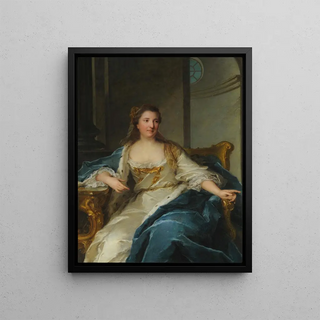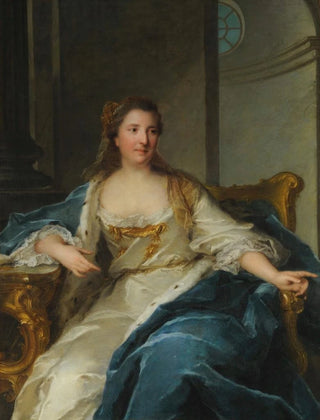Art print | Portrait of Charlotte of Hesse-Rheinfels 1714-1741 Princess of Condé - Jean-Marc Nattier


View from behind

Frame (optional)
In the world of portraiture, some works transcend the simple frame to become living testimonies of an era, a culture, and a personality. The art print of Charlotte de Hesse-Rheinfels, Princess of Condé, created by Jean-Marc Nattier, is one of those creations that captivate the eye and the mind. This piece, painted in the early 18th century, embodies not only the refinement of the French court but also Nattier's artistry, which masterfully brings his subjects to life with remarkable delicacy and psychological depth. Charlotte, an emblematic figure of her time, is depicted with a grace that evokes both nobility and intimacy, allowing the viewer to glimpse the complexity of her existence.
Style and uniqueness of the work
Nattier's style is distinguished by his subtle use of color and light, creating an atmosphere that is both intimate and majestic. In this portrait, Charlotte de Hesse-Rheinfels appears dressed in a sumptuous gown, adorned with refined details that testify to her aristocratic status. The drapery of her clothing, painted with meticulous precision, almost seems to have a tangible texture, inviting the viewer to admire not only the beauty of the princess but also the technical talent of the artist. The softness of Charlotte's features, her contemplative gaze, and her light smile add a human dimension to this representation, making the work accessible and touching. Nattier thus manages to capture not only the external appearance of his model but also a deeper essence, a blend of strength and fragility that characterizes the lives of many women of his time.
The artist and his influence
Jean-Marc Nattier, a French painter of the 18th century, is often regarded as one of the masters of portraiture at the court of Louis XV. Trained in the classical tradition, he knew how to establish himself through his unique style and his ability to portray nobility in a new light. Nattier had the opportunity to work with leading figures, which enriched his artistic approach and allowed him to

Matte finish

View from behind

Frame (optional)
In the world of portraiture, some works transcend the simple frame to become living testimonies of an era, a culture, and a personality. The art print of Charlotte de Hesse-Rheinfels, Princess of Condé, created by Jean-Marc Nattier, is one of those creations that captivate the eye and the mind. This piece, painted in the early 18th century, embodies not only the refinement of the French court but also Nattier's artistry, which masterfully brings his subjects to life with remarkable delicacy and psychological depth. Charlotte, an emblematic figure of her time, is depicted with a grace that evokes both nobility and intimacy, allowing the viewer to glimpse the complexity of her existence.
Style and uniqueness of the work
Nattier's style is distinguished by his subtle use of color and light, creating an atmosphere that is both intimate and majestic. In this portrait, Charlotte de Hesse-Rheinfels appears dressed in a sumptuous gown, adorned with refined details that testify to her aristocratic status. The drapery of her clothing, painted with meticulous precision, almost seems to have a tangible texture, inviting the viewer to admire not only the beauty of the princess but also the technical talent of the artist. The softness of Charlotte's features, her contemplative gaze, and her light smile add a human dimension to this representation, making the work accessible and touching. Nattier thus manages to capture not only the external appearance of his model but also a deeper essence, a blend of strength and fragility that characterizes the lives of many women of his time.
The artist and his influence
Jean-Marc Nattier, a French painter of the 18th century, is often regarded as one of the masters of portraiture at the court of Louis XV. Trained in the classical tradition, he knew how to establish himself through his unique style and his ability to portray nobility in a new light. Nattier had the opportunity to work with leading figures, which enriched his artistic approach and allowed him to






